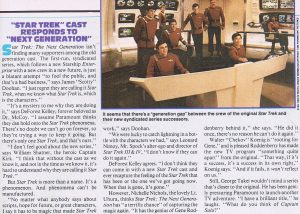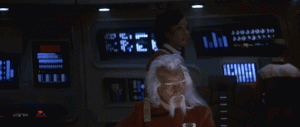Star Trek: The Next Generation tells some great stories, but the story behind how it came to be what it is today is pretty interesting, too; and even what happened behind-the-scenes can teach us a lot about the wisdom of God. This supplemental Trektember miniseries by David Lichty will explore what went on behind the camera, and why it’s important.
• • •
“They had Gene Roddenberry, they had the Star Trek franchise, and then they did a very wise thing. …they happened to have ended up with an amazing group of people, both in front of, and behind the camera.”
LeVar Burton, Journey’s End: The Saga of Star Trek The Next Generation
Without consultation, plans are frustrated, But with many counselors they succeed.
Proverbs 15:22
In addition to Bob Justman, Gene Roddenberry tapped a large number of experienced producers, writers, and creative people in order to start his new show in such a short amount of time. Many even came from the original Trek series.
[pullquote]At this time, Star Trek was not a vision of the future. It was Kirk, Spock, McCoy, Uhura, Sulu, Scotty, Chekov and the Enterprise. That was what Star Trek was, and exactly that.[/pullquote]
Michael Westmore was the make-up supervisor from the start of TNG through the three spin-offs and the last feature film. He and his family had a legacy in Hollywood make-up going back to the silent film era. David Gerrold, who had written for the original series, was brought on board right away after the announcement, followed by another Trek writer, D.C. Fontana. While TNG was in embryo, Gerrold, Roddenberry, Justman and brief producer Eddie Milchus would watch a science fiction movie every morning and discuss it over lunch.
Meanwhile, mostly doubtful speculations about a new Star Trek ran through the articles and letters sections of science fiction themed magazines. 

What was so strange about Kelly’s statement is that in their most recent film, Star Trek IV: The One With the Whales, two other ships’ crews had appeared in the opening 10 minutes, both feeling like lived-in crews, as if the cast of two alternate universe, long running Trek series had made guest appearances in the film. It worked. They felt just like Star Trek.
Seeing the identity of Trek through a similar lens, Paramount originally wanted the new series to have Starfleet cadets running a ship, pushing for young Kirk & Spock, like the 2009 film would later do. Roddenberry didn’t see it this way, so he started coming up with new characters, and ran them by various people to see what they thought.
About 6 months before the show premiered, in the May, 1987 issue of Starlog (these usually hit the stands two months before their cover dates), David Gerrold, who had long written for the magazine and was helping develop the series, wrote a big insider’s update.  He mentioned most of the major changes: that the series was to be set up to 150 years after Kirk, the ship was bigger, and that there was a holodeck, which he said was “…also used by the ship’s Security Chief to train her security squads. (“Her?” Yes. Her.)” His expectation of surprise at a female security chief is funny to me now. In Star Trek IV (1986) the captain of another starship was black woman. In both Star Trek III and the Original Series, the spiritual leader of Vulcan was a woman. In Star Trek II, the top student among the trainees, closest to command, was Lt. Saavik, and the head of the Genesis project was Dr. Carol Marcus. This level of feminism wasn’t such big news for 80’s Star Trek.
He mentioned most of the major changes: that the series was to be set up to 150 years after Kirk, the ship was bigger, and that there was a holodeck, which he said was “…also used by the ship’s Security Chief to train her security squads. (“Her?” Yes. Her.)” His expectation of surprise at a female security chief is funny to me now. In Star Trek IV (1986) the captain of another starship was black woman. In both Star Trek III and the Original Series, the spiritual leader of Vulcan was a woman. In Star Trek II, the top student among the trainees, closest to command, was Lt. Saavik, and the head of the Genesis project was Dr. Carol Marcus. This level of feminism wasn’t such big news for 80’s Star Trek.
Gerrold also ran through the crew (not the cast); most of whom had been established, though some changes came later. Captain Julian Picard would have a name change. Dr. Crusher’s son was still her daughter, Leslie, not yet Wesley; and the security chief was to be Lt. “Macha” Hernandez, part of the deliberately multi-racial crew. By March 23, 1987, a 50-page writer’s ‘bible’ had been compiled, and was distributed to experienced television writers and writers’ agents.
Gerrold wrote monthly updates on development and production for each issue of Starlog that year. This kind of detail seems geeky, but remember how many Trek fans had long given up on a new Star Trek series. Details make things real, and Trekkies liked the assurances Gerrold was providing.
• • •
Trek Backstory will continue! In the meantime, don’t miss our ongoing reviews of the best episodes of Star Trek: The Next Generation. Thanks for reading Redeeming Culture.
• • •
Sources:
Rick Berman Interview | Archive of American Television
Stardate Revisited: The Origin of “Star Trek: The Next Generation” Part 1: Inception (Blu-ray Season 1, Disc 6)
Starlog 117 (04-1987)
Starlog 118 (05-1987)
The Beginning (DVD/Blu Season 1, Disc 6)
Starlog 120 (1987-07)
In Conversation: The Star Trek Art Department (Blu-ray Season 4, Disc 6)


